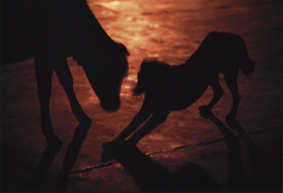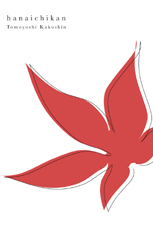24 Dec.
2003 - 18 Jan.
2004
Zhang Shao Jun (Shanghai/China) ![]()
Balanceology
- guan xi xue
black
ink drawing
opening
party
18:00 Tue. 23 Dec.
yin-yang
tea ceremony
0:00 Thu. 1 Jan.
|
|
|
Balanceology - The world of Black Eyes How big is the world of a single grain of sand? "Its
diameter is 0.1mm; its volume is 0.000532 cubic meters; it is found
in an ocean" "The
single grain of sand is one world" The single grain of sand has a previous life as well as a future life. In its previous life, it might have been part of the rock of a magnificent mountain. In the next life, it might be a single crystal in a fog that you happen to observe one day. The single grain of sand is Yin as well as Yang. Yin is nutrition from water; Yang is the warmth of the sun. The single grain of sand is light as well as shadow. Light is the growth process; shadow is the footprints of life. The single grain of sand is something large as well as something small. The largeness is the history of the single grain of sand; the smallness is the space it occupies. Inside the single grain of sand, there is the thirst of a shell for the ocean, the desire of trees for the sunlight, the quest of humans for love. Outside the single grain of sand, there is air, water, earth and the world in which we exist. When we arrive in the red earth of the East, we already have "eyes" different from western ones. Orientals have 'black eyes', westerners have 'indigo eyes'. There are various distances in the world of indigo eyes. People seem to try to investigate spheres by using protons and neutrons, to decode the world by using physics, to surgically remove international problems. The world of black eyes is full of relationships. By being closely linked to others, people try to interpret the relationship between human and human, human and nature, human and the world, trying to communicate with certain natural theories. For human's existence and development, it is necessary to acquire other lives of animals and plants in nature. The coexistence of nature and various things continues eternally as a relationship of balance. In the work of this exhibition, Zhang Shao Jun attempts to decode various relationships - such as the blend of Yin and Yang, the interplay of light and shadow, the transformation of large and small, the experience of inside and outside. The approach of decoding the relationship in the world of black eyes, presents us with a great possibility of balance in the process of deepening ourselves. text:
The friends of Zhang Shao Jun
|
|
|
24
Jan
Kuniyoshi Yashiro
Jazz Drum concert
11
Feb. - 7Mar.
Shinji Komiya
Icthyo-timepiece; Ship of Memory
installation
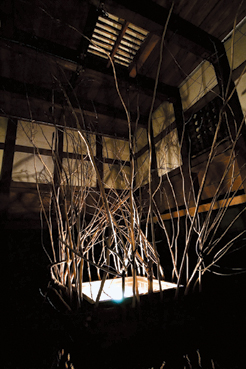
photo: Yukio Morinaga
|
Water tanks send out perpetual ripples. These ripples cast shadows and light of water on the ceiling and walls, spreading out into the whole space. Some draw arches, others create complicated patterns by intricately intersecting each other. Waves alternately sway and decay, and the water gradually permeates the space. I love working in a place where it already has its own atmosphere, including historical background. For example, I have created installations in the ruin of a castle in the Alps, in Yugoslavian dynasty's ballrooms(now in Serbia), in a historic architecture called "Water Tower" in Vienna, in medieval European churches, or in Japanese temples. When a new space presents itself without losing distinctive emotional qualities of the location, I feel like I can step outside of a sense of time. In this installation, fish swim across the space in the old stone storehouse in Asakusa, and the ship of memory floats in one's awareness. ----------------
Shinji Komiya
Shinji Komiya biography Born in Hakodate, Hokkaido, Japan in 1961, finished the postgraduate program at Tama Art University, Tokyo in1987. Exhibitions (selection) 2003 2002 2001 2000 1999 1998
Projects (selection) 2003 2002 2001 2000 1999
|
19:30 11/13 Mar.
Kakushin Tomoyoshi
hanaichikan vol.8
SATSUMA Lute concert & lecture
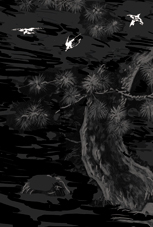
painting: Roman Scheidl
19 Mar. - 12 Apr.
Irena Khaikin-Peer ![]()
IMMATERIAL
textile
supported by: Embassy of Israel
opening reception
19:00 Thr. 18 Mar.
live music by Nobara
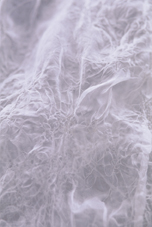
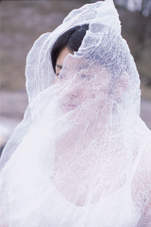
photo: Kanki Matsumura
|
"immaterial" is a transformation of mathematically designed images into tactile delicate textiles. Irena Khaikin biography Irena Khaikin was born in Siberia, Russia, and moved to Israel in 1993. She studied textile design in Ivanovo, Russia and Shenkar College of Textile Technology and Fashion in Israel (B.A. with honors). In 1999 she was granted the Monbusho scolarship, an invitation for research and study in Japan, and completed an M.A. degree in Tama Art University. Currently, Irena is a PhD researcher at Tama Art University, and is working as a freelance textile designer for both interior and fashion markets. Her designs and fabrics are featured in collections by Creation Baumann, WiseWise and Ozone Rocks. In her current project she is researching the relationships between computer-made vs. hand-made and artificial vs. organic, and is creating patterns for digital and hand printing. The specially designed software is a result of collaboration with computer artist Shinya Matsuyama. |
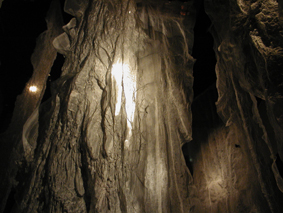
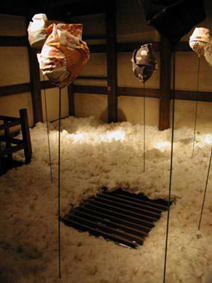
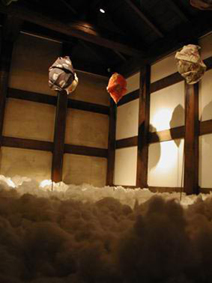
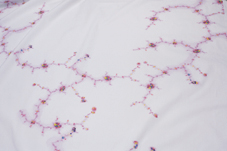
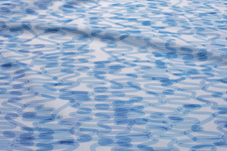
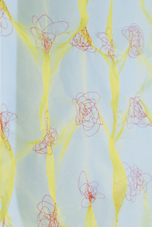
17 Apr.
TRASH DANDY
happenings & performance at bar
Cushla
(NZ) Guidance
Ben Frost (AUS) The 1981 President
Reagan Assassination Attempt
Steffi Jüngling (GER) This is why
Ben Schwartz beat poetry
DJ THE JET PLANE surreal tracks
19:30 24/25 Apr.
Kakushin Tomoyoshi
hanaichikan vol.9
SATSUMA Lute concert & lecture about Japanese traditional performing
art
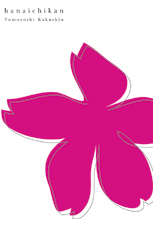
Gallery éf 7th Anniversary
Exhibition
29 Apr. - 21 Jun.
Thomas Bohle ![]()
ya shi
ceramic (stoneware)
supported by Austrian
Embassy/ Cultural Forum, Vorarlberg State Government
in collaboration with Daniela Egger, JIBO
cooperation: A&G ALPS, Plaza Gallery
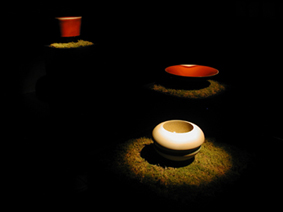
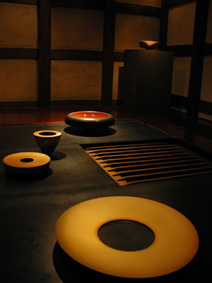
|
A bowl made
by Thomas Bohle At the other end of the room there is a bowl. The face of this bowl seems to consist of pure floating, made from a body of air, which uses the materialistic compound only as a manner to show himself. The precise design does not only conceal any trace of the making, but allows the bowl itself to become invisible. You can never be sure how many steps there are to reach the bowl. Its floating precence fills the whole room. It seems as if every step is done in its expanded body. As if we ourselves were inscribed in its infinite close distance. In its inner ground the bowl opens ways like in a dreamt Hinterland. Breath. Earth. Breath. translation: Steffi Juengling |
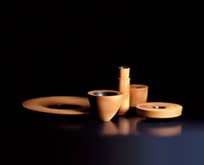

photo: Frigesch Lampelmayer
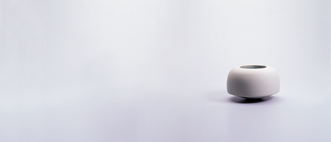
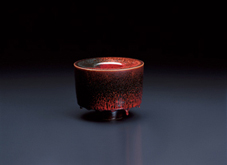
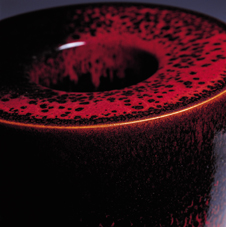
19:30 24/26 Jun.
Kakushin Tomoyoshi
hanaichikan vol.10
SATSUMA Lute concert & lecture about Japanese traditional performing
art
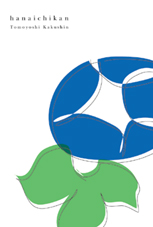
16
Jul. - 16 Aug.
Collapsing Histories
curation: Aaron Kerner ![]()
mixed
media
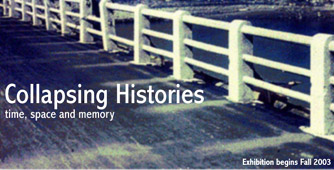
| War,
genocide and terrorism. The 20th Century is lined with numerous catastrophes.
And as we embark on this new century there seems to be no end to the
catastrophic experience. Through highly advanced media we can see
catastrophic images in real time (e.g., the collapsing of the World
Trade Center, the American bombing and invasion of Iraq). The impact
of individual images circulating in the mass media, or objects charged
with personal memory might have strong resonance, but with the passage
of time the emotional charge might dissipate. The events which are
unfolding today are in a sense a repetition of catastrophic histories.
"Collapsing Histories ~ time, space and memory ~"is an exhibition that focuses on vanishing histories. None of the artists, with the exception of Binh Danh, have directly experienced the catastrophic events they depict. For some of the artists it is their parent’s who lived through a catastrophic episode, such as war or the Holocaust. The artists negotiate catastrophic history through their artwork. The Second World War, the Pacific War, the Holocaust, the use of atomic bombs, nuclear development, the Vietnam War, the Chechen war and a series of terrorist attacks, 9-11 are themes touched upon, but the exhibition also addresses how these events are contextualized in history, in time, space and memory. The images of catastrophic events, which slip from personal and cultural memory, are preserved in the artwork. Fourteen artists
from the U.S., Japan and the U.K. are participating in this exhibition,
responding to the call of the curator, Aaron Kerner (Assistant Professor
at San Francisco State University). The artists try to uncover and
discover the vanishing images of histories with each own expression:
painting, photography, printmaking, textiles, mixed media and video
installations. Most of the foreign artists are showing their works
for the first time in Japan. The exhibition venues are the Daigo Fukuryu Maru Exhibition Hall and Gallery éf. And what makes this exhibition of Collapsing Histories special (it was previously exhibited at the University of California Santa Cruz) is that the exhibiting venues themselves are as important as the exhibited artwork. The Daigo Fukuryu Maru Exhibition Hall preserves a wooden fishing vessel that was exposed to deadly radioactive fallout after an American hydrogen bomb test in the Bikini Atoll fifty years ago. Gallery éf is wooden warehouse that survived earthquakes and the American fire bombing nearly sixty years ago. As witnesses to history, these two venues are appropriate for the concept of Collapsing Histories ~ time, space and memory. collaborate exhibition venue
July 16th
to August 15th Opening Hour 9:30~16:00 Address 3-2,
Yumenoshima, Koto-ku, Tokyo Traffic Access
Artist
Talk event
15:00~, July 17th
Traffic
Access Between Two venues About Artists Sally Clark/ photograph Sally Clark's
photographs look like European postcards, however, they are all
tinged with horror. All these images are former concentration camps. Ian
Everard/ painting and found photograph These are paintings, not photographs. Ian Everard very carefully has recreated found photographs using watercolor. The images that Everad chooses to paint, often find current resonance. For example, in these images we see a procession of POWs and soldiers wearing chemical suits. All of this seems to bring to mind current world concerns and conflicts; we have to wonder have we learned anything?
James
Fee/ photograph
Binh
Danh/ mixed media photograph Binh Danh was born in Vietnam and during the close of the Vietnam War, like many others, his family fled eventually landing in the United States. Although too young to remember this experience, in many ways the experience is inside him – in his flesh and bone. Binh Danh has used iconic images from the war and grown them into leaves. Like Binh Danh’s flesh and blood experiences, the leaves bear the traces of that conflict.
Shelby
Graham / mixed media photograph Shelby Graham actually lived in Japan for two years. During her stay she found this photograph of a schoolgirl in the trash. Intrigued by the photograph and why this image – which means something to someone – would be cast way, she has re-framed it. Suspending the image beneath a web of rice-paper and the ominous form of a missile, the juxtaposition of these forms begins to construct a set of new meanings, and new memories.
Robynn
Smith / painting Smith has superimposed an image of downtown Grozny after being bombarded by the Russians, with the ruins of the WTC site. Here we have two urban centers wrecked by violence. The print is based on this photograph of Grozny which appeared in the New York Times.
Keith
Muscutt /
installation Keith Muscutt is the son of George Muscutt, the material seen here are original documents which record the surrender of British led troops to the Japanese. Also included here is George Muscutt's wallet which he kept during his imprisonment in a Japanese POW camp.
Robin
Kandel / video installation Robin Kandel's father survived the Holocaust by living in the forest for 18 months. Her video installations reflect some of his experiences: burying dead relatives in the forest, creating shelters during the winter months by digging holes and covering them with branches and leaves.
Nakahashi
Katsushige / photographs and
video History fascinates Nakahashi Katsushige, but not just the subject of history, rather the history that is locked up in specific places and time. Nakahashi presents an incredibly important piece, documenting 50 years to the day, March 1, 2004 the detonation of the Bravo Test Blast in the Bikini Atoll. In a piece – a la David Hockney – Nakahashi has reassembled the place which encapsulates the remains of American atomic test blasts which has resulted in the death and suffering of untold numbers of people.
Aaron
Kerner / video installation The United States has gone to great length to re-assure itself about the use of atomic weaponry. Even the first Godzilla, which was released November 3, 1954, several months following the radiation of the Daigo Fukuryu Maru, was radically changed for American audiences, virtually erasing any content pertaining to American use of atomic weaponry. The video includes the opening sequence of the American and Japanese version of the first Godzilla. In addition there are clips from American civil defense films, which – among other things – explains the ‘benefits’ of atomic energy, and how to survive an atomic attack and fallout.
Rebecca Ramos / mixed media photograph Rebecca Ramos
has layered multiple images to create a layered print. The images
that she chooses to work with reference the use and testing of American
atomic weaponry. Her work is something like a map, outlining how
atomic weaponry affects the landscape and the people who live near
these sites.
Elyse
Koren-Camarra
/ textile collage This is a clear vinyl piece, in the shape of a kimono, which will be draped over another piece by Koren-Camarra, entitled Kimono (Unfinished). Inscribed on the clear plastic is material that was dropped from American airplanes over Hiroshima. The text encourages the Japanese people to resist their government, and to "abandon your cities." The leaflets warned the Japanese of their 'prompt and utter destruction,' as stated in the Potsdam proclamation.
Hanna
Hannah / painting on paper Hanna Hannah draws from media sources (e.g., Associated Press photographs). Because we are inundated with media images, we seem completely immune to the horror. Paradoxically Hannah attempts to return some of the horror of the images by placing them in what we might consider a decorative background.
Kenji
Yanobe / video installation – mixed media Along with Nakahashi, Yanobe is one of Japan’s most important contemporary artists. In the past Yanobe has presented sculptural pieces that are designed as post-atomic survival suits. His survival suits while ‘deadly serious’ are also humorous. The video installation continues this approach by turning the issue of atomic weapons and energy into ‘child’s play.’ The video installation contrasts video clips from Atomic Café and from home videos. Video monitors are placed inside a something like a dollhouse.
Shiozawa
Hideki
/ Photograph This photograph was taken in the tribal territory, Dharra of Pakistan. This area is ruled by tribal law, not by the national law. So it is allowed to manufacture weapons. Together with his father and elder brother, this boy was working as a weapon craftsman without question.
|
15 -
30 Sep.
Steffi Jüngling ![]()
room4love.com
interractive art/ installation
in collaboration with:
HOTEL SUNFLOWER, Asakusa, Tokyo
sponsored by SEVEN BED, SHOWA BOEKI Co., Ltd.
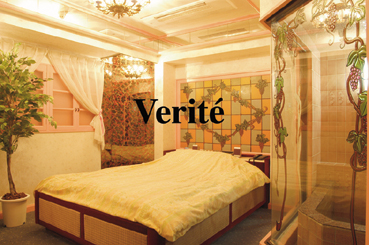
German artist Steffi
Jungling creates a fictional LOVE HOTEL which has three real doors inviting
you to love.
The 1st door is in a real love hotel "SUNFLOWER" in Asakusa
which has 39 various rooms. Jungling installs 39 love stories, which are
inspired by the book "Fragments d'un discours amoureux" ("Fragments
of a language of love"); by the French philosopher and writer, Roland
Barthes, a different one in each room, where they act like lucky charms
or title for each room.
The 2nd door is on web "www.room4love.com",
which shows all the stories and rooms which correspond to the real love
hotel. You can send your own love stories to the site, you are welcome
to contribute to room4love.
The 3rd door appears in Gallery ef, also in Asakusa, as an installation
of "room for love", which provides you an idea of being in a
love hotel relaxed.
By this an imaginary space for love will be created, where reality and
fiction merge and the individual visit becomes part of a "love-fictional".
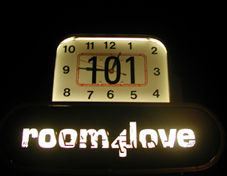
NOTICE: SUNFLOWER is in business. You cannot tour around the real love hotel. Please check in for STAY or REST following its system.
|
A "Love
Hotel" is a space for lovers who want to satisfy their desire
and to be alone. Japanese people are quite familiar with the idea
of a love hotel, but for foreign people it seems a very exotic concept. Steffi Jungling,
a German female artist, creating installation works with the motif
of literature, is one who is inspired by the Love Hotel. She will
start an art project, “room4love”, on the stage of a real love hotel,
website and art gallery. This hotel has
thirty-nine rooms and Steffi will display a message in each room.
The content of the message is a short love story written in the
motif of "Fragments d'un discours amoureux" ("Fragments
of a language of love") by the French philosopher and writer,
Roland Barthes. When lovers enter a room, they will meet the fragment
of a love story, created by Steffi’s imagination. In addition
to this real hotel, a website “room4love.com” will make thirty-nine
rooms. Each room will display the same message as the real room
and a panoramic photograph of its unoccupied interior. The visitors
in the real room can get the message, access the website and send
their own message such as their own stories in the room or their
own love experience. Of course, visitors to the website can send
their message, even though he/she does not go to the real love hotel. One more gate
to this love hotel will appear at Gallery ef, an art space in Asakusa.
This building was built in the Edo period, 136 years ago. Steffi
will create an installation, “room4love”. During regular opening
hours, 11:00 to 19:00, the audience will be able to see this room
without charge, and after 19:00, visitors can stay just by themselves
for a charge of 1,000 yen per hour per person. It is possible to
order drinks from the bar.
|
3
Sep. - 21 Nov.
Music Month
Forest under The Moonlight
Gallery éf presents
annual live event of autumn "Forest Under The Moonlight". A
wide variety of musicians participate this event, such as Jazz, Japanese
Imperial music, ethnic and Baroque music.
All the concerts will be held in gallery space, which was built in 1868
as a clay warehouse and the number of audience is limited as 25 persons.
In the relaxed autumn air, you can feel the harmony of clay, wood, sound
and even breathing of musicians.Live Month "Forest Under The Moonlight
vol.3"
|
Ten-Ku
: Ethnic Instruments Unit Jazz:
Kuniyoshi Yashiro (Drums) / Testuro Ueno (Bass) / Atsuo Takahashi
(Sax) Un-ryu:
Oriental Flute Kakushin
Tomoyoshi: Satsuma Lute (Biwa) Kazue
Tajima:
Shinto Flute Jazz
:
Toshio Miki (Tenor Sax) / Shin Kamimura (Bass) Takashi
Kougo and KOH-TAO:
Northern Indian instrument "Esraj" and ethnic instruments
unit Gyoten,
Toshi,
and Hana: Ethnic Music Concert
for Children Duo
Lutin: Baroque Music Unit |
12
- 21 Nov.
Christof Cargnelli
(Austria) ![]()
Second
Order Circuit
Sound Installation
supported by Austrian
Embassy/ Cultural Forum
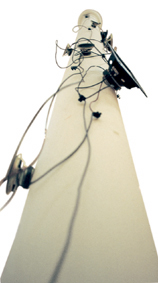
Austrian artist Christof Cargnelli creates his sound/light installation in a traditional two-storied warehouse built in 1868 in Tokyo - Gallery éf.
The individual reception
of the installation depends mostly on the position of the visitor within
the space. The ground floor is structured through neon lights, flickering
only for split seconds, constantly creating visual variations of the same
space. The sound develops in all directions and creates new spatial horizons.
Starting from the upper floor the space fills up and the sounds begin
to spin upwards through the system of interlocked loudspeakers; reaching
the ceiling and gliding down along the walls like waterfalls.
The space begins to breathe, similar to an organism which reacts to an
external impulse. The quantity of the stimulus creates the breath - allowing
the room to fluctuate between micro - and macro-organic states.
4
- 18 Dec.
Railway goods collection

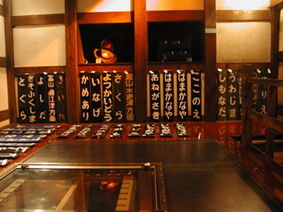


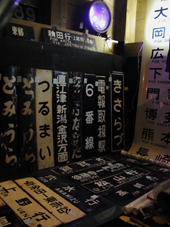
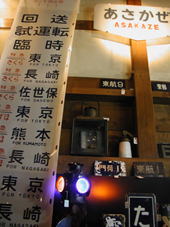
precious
collection of Mr.Setouchi,
part of his 70years' collection
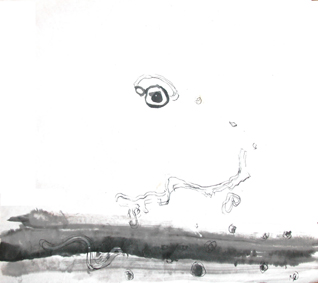
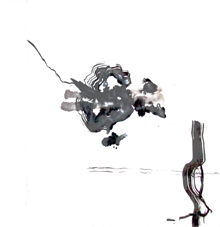
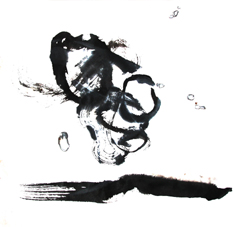
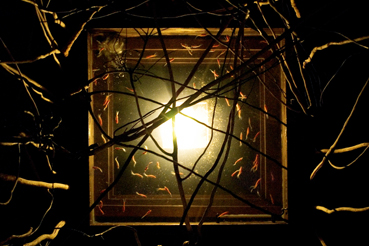
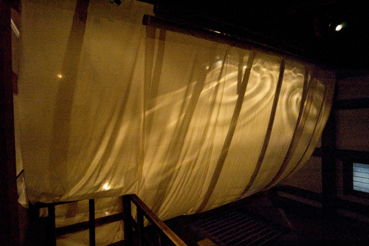
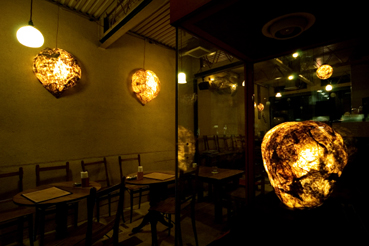
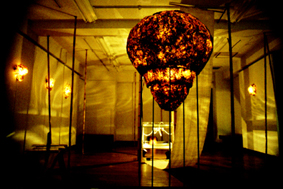
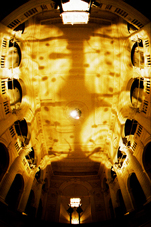

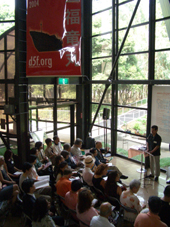 Daigo
Fukuryu Maru Exhibition Hall
Daigo
Fukuryu Maru Exhibition Hall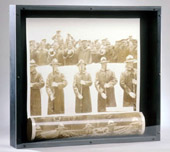
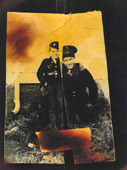
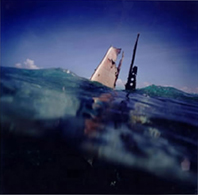


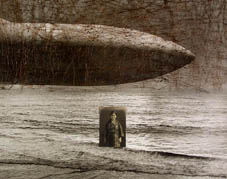
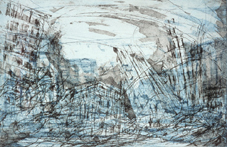
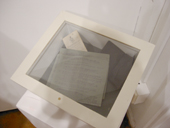
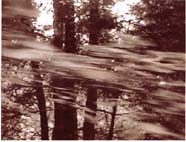
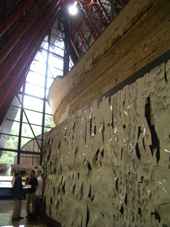
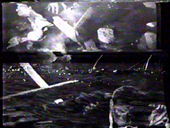
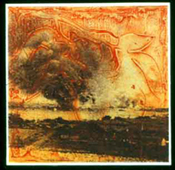
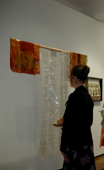
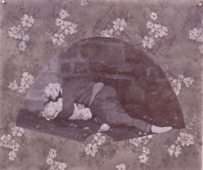
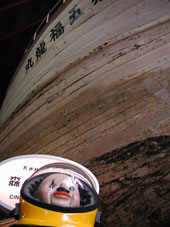
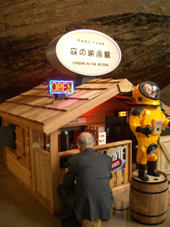
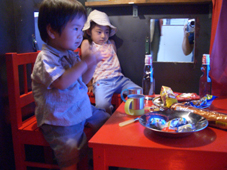
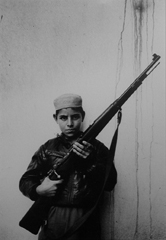
 room4love
room4love
